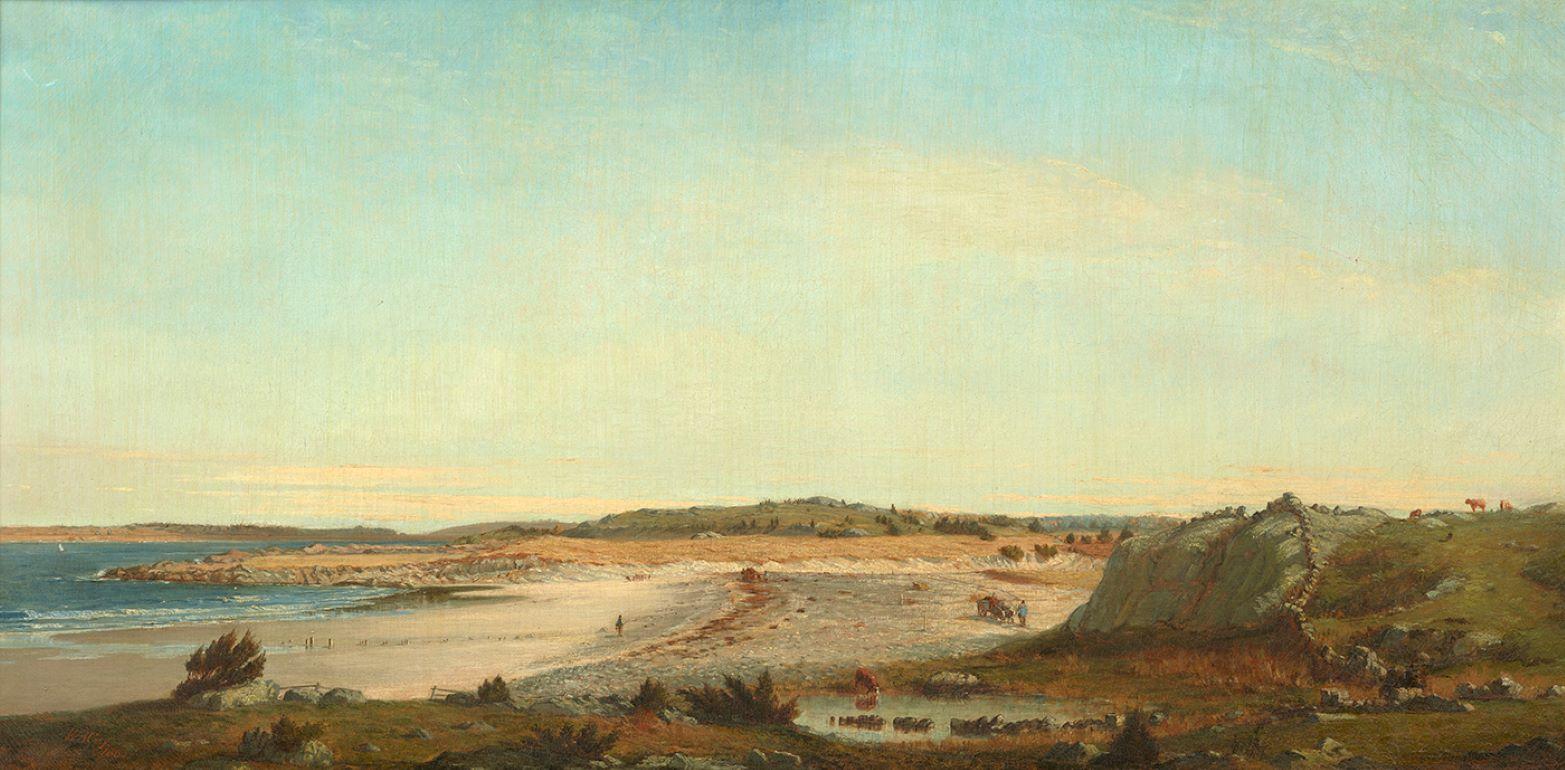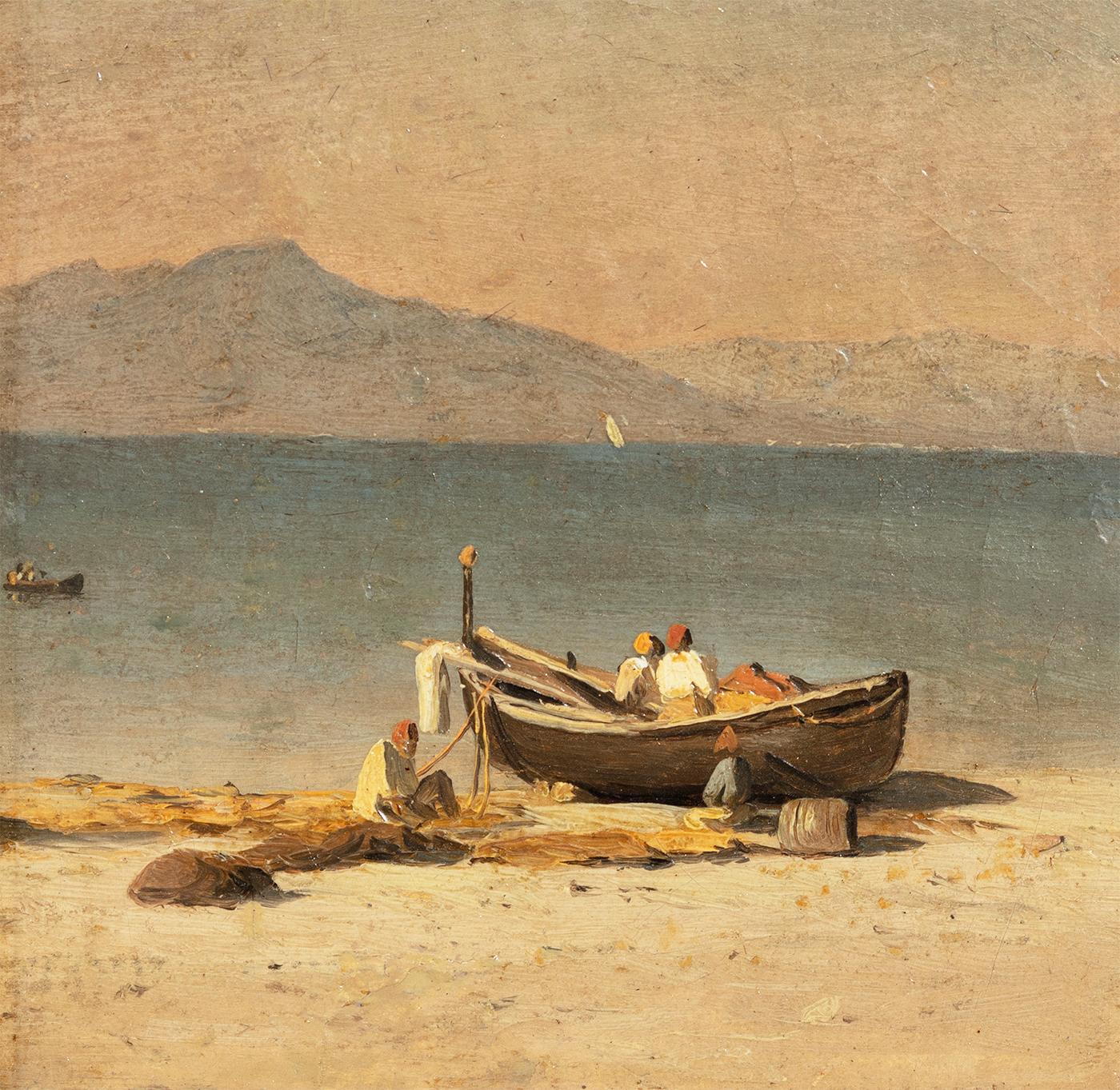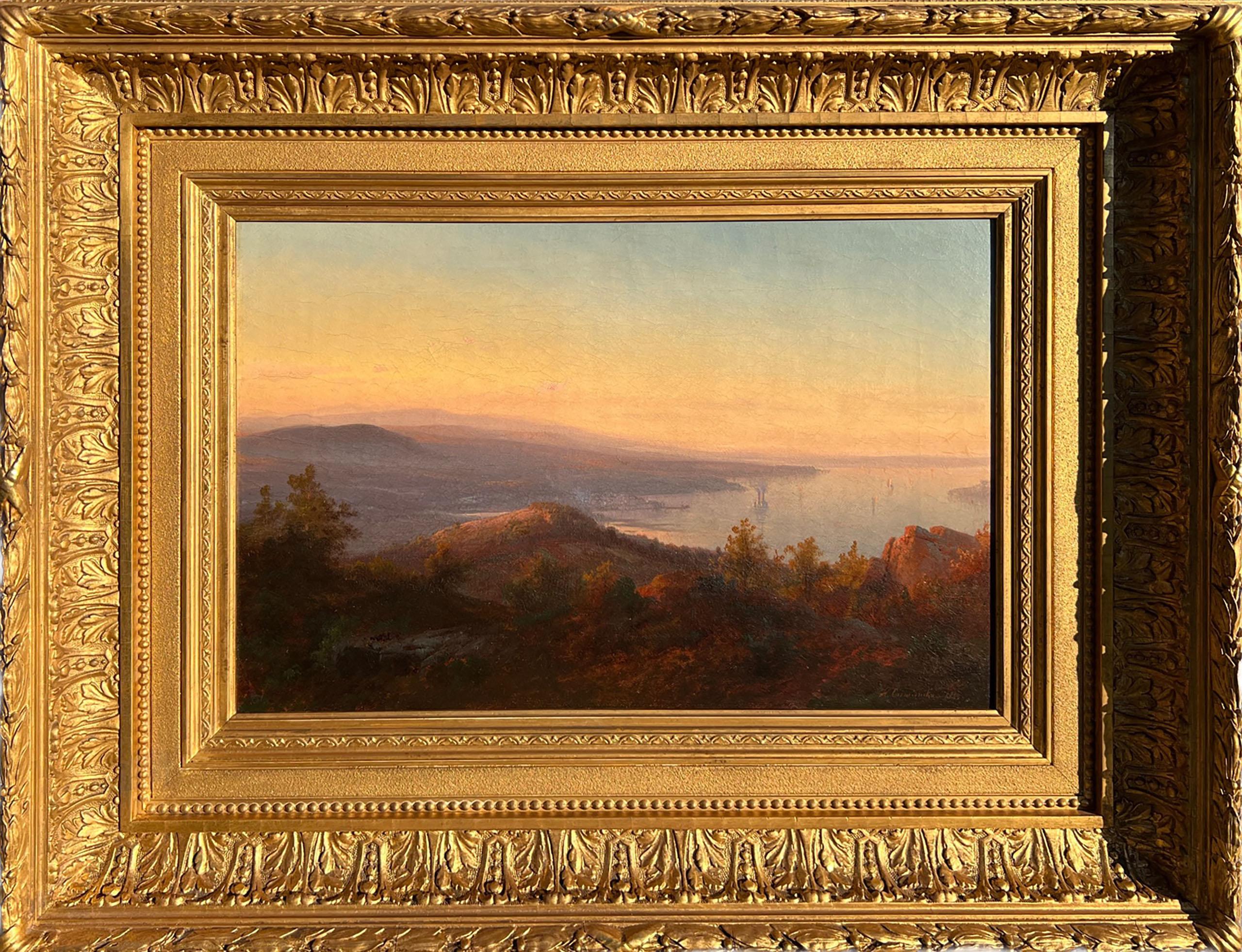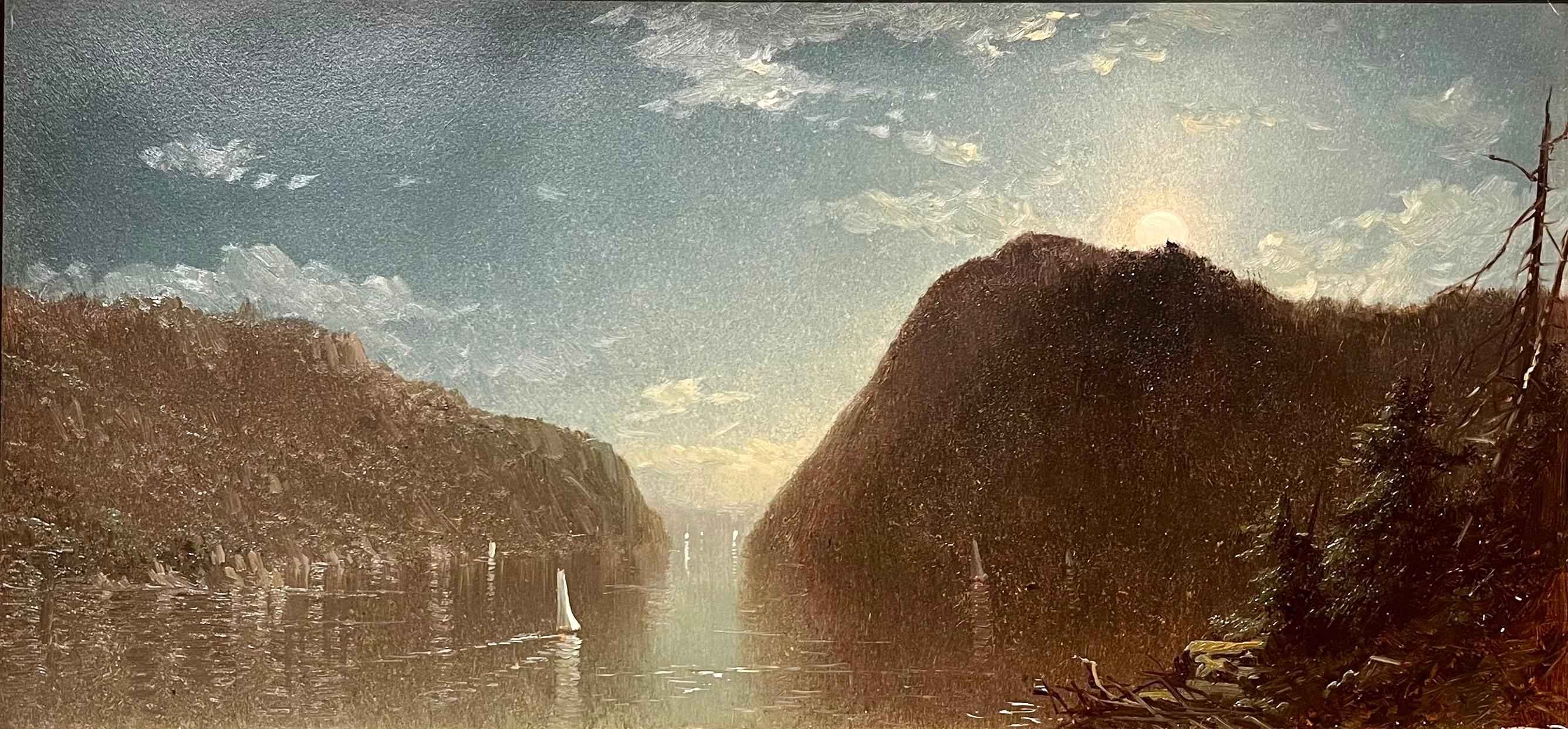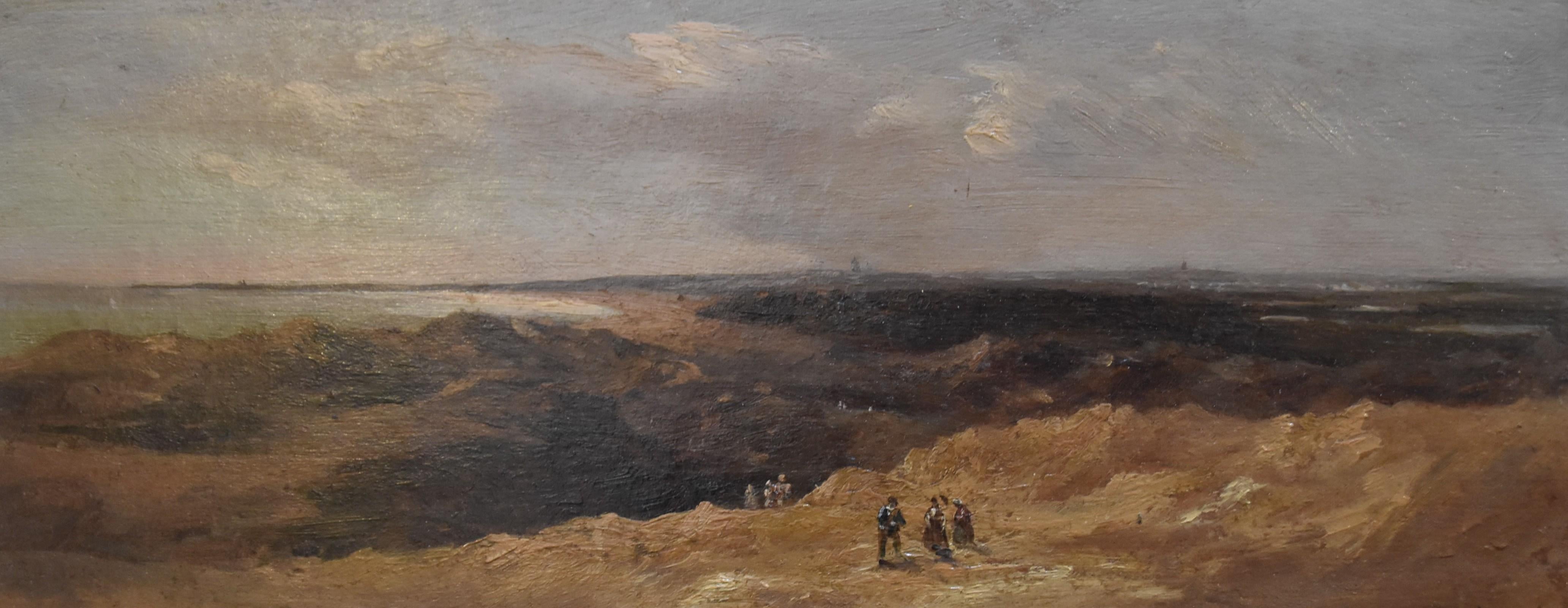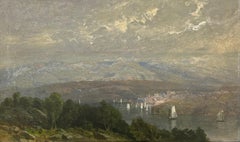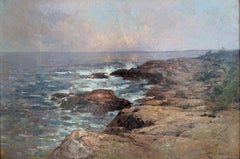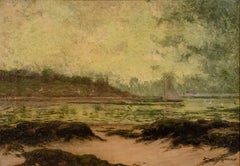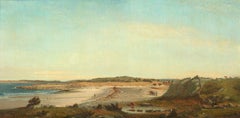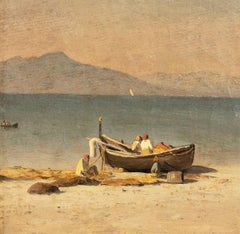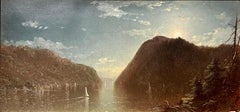Items Similar to "Clay Bluffs on No Man’s Land" Sanford Gifford, 19th Century Luminist Landscape
Want more images or videos?
Request additional images or videos from the seller
1 of 5
Sanford Robinson Gifford"Clay Bluffs on No Man’s Land" Sanford Gifford, 19th Century Luminist Landscape1877
1877
$60,000
£45,073.68
€51,977.28
CA$83,257.83
A$92,517.81
CHF 48,480.31
MX$1,134,566.05
NOK 618,338.18
SEK 581,709.86
DKK 387,936.33
Shipping
Retrieving quote...The 1stDibs Promise:
Authenticity Guarantee,
Money-Back Guarantee,
24-Hour Cancellation
About the Item
Sanford Robinson Gifford
A Sketch of Clay Bluffs on No Man’s Land, South of Martha's Vineyard, 1877
Stamp on verso of canvas: S. R. Gifford [estate] Sale
Typed label on upper stretcher bar of verso: Clay [effaced] Man’s Land
Oil on canvas
9 1/16 x 16 3/4 inches
A Sketch of Clay Bluffs on No Man’s Land, not signed or
dated, is the larger and later of two versions of the subject by Sanford Gifford that have recently come to light.[i] Gifford completed as many as six paintings, three dated 1877, one 1878, that must all stem from one recorded visit he made in October 1877 to the small, now uninhabited island today known
as Noman's Land, three miles southwest of Martha’s Vineyard, Massachusetts.[ii] The artist’s primary objective may have been fishing, an avid pursuit of Gifford’s that he depicted in three of the paintings of Noman's Land. In two of those works, the artist essentially flipped the point of view, shifting the
island’s eastern bluffs from left to right and silhouetting them in the glare of a visible sunset.[iii]
In the handling of the terrain, the present painting is
richly executed, with buttery strokes of pale earthen pink, tan, and buff pigments, in some places seemingly dashed onto the canvas, yet cohering marvelously to convey the solid yet friable nature of the mostly sedimentary geology, as well as the warmth imparted to it by the broad light of a clear late morning or midday sun. The beach, punctuated by large boulders, appears to
mingle sandy and solid surfaces, up to which, at right, gentle ocean surf breaks ashore. Contrastingly, the sky is rendered mat with something like pointillist application: small, unmodulated daubs, blue gray above and grading into a dull
rose at the horizon, akin to the warmth of the bluffs. The artist sketched in at least five rudimentary human figures, one nearest the viewer at far left, one most distant on the base of the bluff at right, and three at center, two standing and one seated in profile.
Of the known paintings of Noman’s Land, the present work and
another bearing the same title, signed and dated 1877, appear very closely related, as if done in succession, even possibly worked on the same day.[iv] It is easy to imagine the dated painting as dependent on the present one as a template, but embellished with a fisherman seated on a chair on an elevated
dock, overlooking ranks of small breakers rolling to the shore, now nearly consumed by a risen tide. In the dated picture, the artist also broadened the point of view, setting the bluffs at a farther remove from the viewer and lending more picture space to the ocean horizon and the surf. In the present painting, what appears to be late morning or midday sunlight from high above
the setting, in the dated picture becomes a low, late afternoon glare trending from the left, presumably west. It warms and saturates the tint of the bluffs even more than those in the present painting and casts slender cool shadows from the nearer bluff at left onto the farther. If the sequencing here can be
only theoretical, the essential kinship between the present painting and the dated one looks undeniable.
The whereabouts of the present painting were unknown when
The Metropolitan Museum of Art and the National Gallery of Art mounted a major retrospective of Sanford Gifford’s work, in 2003. But the dated version of the subject that includes the fisherman, described above, was identified in the exhibition catalogue by the same title.[v] The titling undoubtedly originated in a reference in the 1881 memorial catalogue of Gifford’s known work: no. 656,
“A Sketch of Clay Bluffs on No Man’s Land,” listed as “Not Dated,” dimensions 9 x 16 ½ inches, “Owned by the Estate.” [vi] Those are all features and circumstances consistent, less with the painting including the fisherman, than with those of the present work. The verso of the canvas bears a Gifford estate sale stamp: the painting is undoubtedly the “Clay’s [sic] Bluff on No Man’s
Land. Not Dated. 9 x 16 ½,” sold at Kirby’s and Co. auctioneers at 845 Broadway, on Thursday, 28 April 1881, eight months after the artist’s death; the sale catalogue entry includes a reference to the memorial catalogue entry, no. 656, cited above.[vii] The dated painting of the same title that has been described by previous authors as no. 656 may well be Memorial Catalogue no.
659, “Bass-Fishing at No Man’s Land, a Study. Dated 1877.” According to the catalogue, that picture by 1881 had been sold to a private collector in Providence.[viii]
As fine a work as the dated painting is, in the present one
Gifford managed his most fully realized direct impression of what he found when he reached Noman’s Land in October 1877. The only other sketch in oils known, presumably preceding this one, is relatively raw, cramped and cursory, while the glowing, dated painting described above (probably “Bass-fishing at No Man’s
Land, a Study”), betrays premeditated schemes, such as the converging perspective lines of the waves that mark the distance to the principal motif of the bluffs beyond. The synthetic impulse detectable in the dated painting became only stronger in what must be Gifford’s ultimate conception of the subject, the large Sunset on the Shore of No Man’s Land—Bass Fishing, dated
1878 (private collection). There, in familiar homage to his artistic exemplar, J. M. W. Turner (and, to a lesser extent, to his New York colleague Frederic E. Church), Gifford reached for the radiance and spatial breadth of what he termed his “Chief Pictures,” reversing the point of view toward the blinding sun,
suspended above the ocean horizon, with the silhouetted bluffs towering above at right. In contrast, the newly revealed Clay Bluffs on No Man’s Land betrays the freshness, even strangeness, of discovery—of a virtually deserted isle in
the Atlantic that, for Gifford, might have felt at first like another planet.
[i] The other painting, No Man’s Land (private collection),
shown to the author in 2016 and again earlier this year, is smaller and probably earlier, to judge from its more cursory execution; also alluded to below in the text.
[ii] “Reopening the Studios,” New York Tribune, 13 October
1877, p. 2: “Mr. Sandford [sic] R. Gifford has found a new haunt on No Man’s Land, a dreary island, inhabited by three families, south of Martha’s Vineyard. What he has found there is still unknown; hence there will be the greater curiosity to see his new work.” In the twentieth century Noman’s Land, all of 612 acres, became completely deserted, and was used by the United State Navy as
a bombing range until 1996. Today it is a wildlife sanctuary. For discussion of the site and some of Gifford’s paintings of it, see Ila Weiss, Sanford Robinson Gifford (1823-1880). Ph.D. diss, Columbia University, 1968. Rpt. New York: Garland Publishing, 1977, p. 347 and fig. IX I 4: a now unlocated study of a an escarpment with pine tree overlooking the sea, dated October 3, 1877,
illustrated and discussed by Weiss as possibly a Noman’s Land subject is almost certainly not one, since it was made more than a week before the New York Tribune located the artist at Noman’s Land and two weeks before the artist dated his earliest recorded Noman’s Land subject, A Sketch of No Man’s Land,
dated October 22d, 1877 (location unknown). The dated sketch is recorded in A Memorial Catalogue of the Paintings of Sanford Robinson Gifford, N. A. (New York: The Metropolitan Museum of Art, 1881), no. 655. Moreover, Weiss did not cite the study again in her 1987 monograph on Gifford, cited here: Ila S. Weiss, Poetic Landscape: The Art and Experience of Sanford R. Gifford (Newark: University of Delaware Press, 1987), pp. 310-311; Ila Weiss, “Reflections on Gifford’s Art,” in Sanford R. Gifford, exhibition catalogue (New York: Alexander Gallery, 1986), n.p. and no. 41; Kevin J. Avery and Franklin Kelly, eds., Hudson River School Visions: The Landscapes of Sanford R. Gifford, exhibition catalogue, The Metropolitan Museum of Art and the National Gallery of Art (New York and Washington, D.C., 2003), pp. 219-221; Kevin J. Avery, “The Enchantment of Sanford R. Gifford,” in Kevin J. Avery and Donald A. Christensen, An Artist’s Legacy and a Dealer’s Admiration: Paintings by Sanford Robinson Gifford from Important American Collections, exhibition catalogue (New
York: Michael Altman Fine Art and Advisory Services, 2012), pp. 130-131.
- Creator:Sanford Robinson Gifford (1823-1880, American)
- Creation Year:1877
- Dimensions:Height: 9 in (22.86 cm)Width: 16.75 in (42.55 cm)
- More Editions & Sizes:Unique workPrice: $60,000
- Medium:
- Movement & Style:
- Period:
- Condition:
- Gallery Location:New York, NY
- Reference Number:1stDibs: LU1841215199312
About the Seller
5.0
Platinum Seller
Premium sellers with a 4.7+ rating and 24-hour response times
Established in 2022
1stDibs seller since 2022
114 sales on 1stDibs
Typical response time: <1 hour
- ShippingRetrieving quote...Shipping from: New York, NY
- Return Policy
Authenticity Guarantee
In the unlikely event there’s an issue with an item’s authenticity, contact us within 1 year for a full refund. DetailsMoney-Back Guarantee
If your item is not as described, is damaged in transit, or does not arrive, contact us within 7 days for a full refund. Details24-Hour Cancellation
You have a 24-hour grace period in which to reconsider your purchase, with no questions asked.Vetted Professional Sellers
Our world-class sellers must adhere to strict standards for service and quality, maintaining the integrity of our listings.Price-Match Guarantee
If you find that a seller listed the same item for a lower price elsewhere, we’ll match it.Trusted Global Delivery
Our best-in-class carrier network provides specialized shipping options worldwide, including custom delivery.More From This Seller
View All"Grand Manan" Harrison Bird Brown, Maine Landscape, Hudson River School Seascape
By Harrison Bird Brown
Located in New York, NY
Harrison Bird Brown (1831 - 1915)
Grand Manan
Oil on canvas
12 x 20 inches
Signed with initials lower left
Harrison Bird Brown was born in 1831 in Portland, Maine, and is best known for his White Mountain landscapes and marine paintings of Maine's Casco Bay...
Category
Late 19th Century Hudson River School Landscape Paintings
Materials
Canvas, Oil
"West Point" John Ferguson Weir, Hudson River School Landscape with Sailboats
By John Ferguson Weir
Located in New York, NY
John Ferguson Weir
West Point, 1873
Signed and dated lower left
Oil on panel
12 1/8 x 20 1/8 inches
Provenance:
Sotheby's Arcade, American Paintings, December 19, 2003, Lot 1091
Spanierman Gallery, New York
Private Collection, New York (acquired directly from the above)
Exhibited:
Roslyn, Nassau County Museum of Fine Art, William Cullen Bryant, The Weirs and American Impressionism, April 24, 1983-July 31, 1983.
A painter, sculptor, writer, and teacher, John Weir was a highly talented man whose painting was overshadowed by his father, Robert Weir, the long-time West Point Academy drawing teacher, and his brother, J Alden Weir, well-known impressionist painter.
His distinguished reputation was primarily based on his accomplishments as a teacher and administrator. For many years, from 1869 to 1913, John Weir was the Director of the Yale University School of Fine Arts. He was also a commissioner of the art exhibition at the Centennial Exposition in Philadelphia.
Weir was born at West Point, New York, and by age 20, had a studio in New York City in the Tenth Street Studio Building, the first building in America dedicated to art studios, and there he associated with many leading painters of the day.
He earned attention early in his career for paintings of industrial scenes...
Category
1870s Hudson River School Landscape Paintings
Materials
Oil, Panel
"Coastal Scene" George Henry Smillie, Hudson River School, Rocky Coast, Cloudy
By George Henry Smillie
Located in New York, NY
George Henry Smillie
Coastal Scene
Signed lower right
Oil on canvas
20 x 30 inches
Provenance
Collection of Sylvia and Saverio Giammalva, Houston, Texas
The career of George Smill...
Category
1880s Hudson River School Figurative Paintings
Materials
Oil, Canvas
"Shelter Island, Long Island" Julian Onderdonk New York Coastal Landscape
By Julian Onderdonk
Located in New York, NY
Julian Onderdonk
Shelter Island, Long Island, New York, circa 1905
Signed "Chas Turner" lower right
Oil on canvas
14 x 19 1/2 inches
Julian Onderdonk was...
Category
Late 19th Century American Impressionist Landscape Paintings
Materials
Canvas, Oil
"East Hampton, New York" George Henry Smillie, Hudson River School, Long Island
By George Henry Smillie
Located in New York, NY
George Henry Smillie
East Hampton, New York, 1884
Signed lower left
Dated lower right
Oil on canvas
15 x 24 inches
Provenance
Cigna Museum and Art Collection
Questroyal Fine Art
T...
Category
1880s Hudson River School Figurative Paintings
Materials
Canvas, Oil
"Mt. Rosalie, Colorado" Albert Bierstadt, Western American Mountain Landscape
By Albert Bierstadt, 1830-1902
Located in New York, NY
Albert Bierstadt
Mt. Rosalie, Colorado, circa 1863
Signed lower left: ABierstadt; inscribed on verso: Mt. Rosalie / Colorado
Oil on paper
13 1/4 x 9 1/2 inches
Provenance
Private Co...
Category
1860s Hudson River School Figurative Paintings
Materials
Paper, Oil
You May Also Like
Sandy Beach, Cohasset, 1860
By Winckworth Allan Gay
Located in New York, NY
Winckworth Allan Gay paints a scenic coastal scene from an elevated perspective overlooking a wave-filled beach below in his work entitled, “Sandy Beach, Cohasset.”
Category
Mid-19th Century Hudson River School Landscape Paintings
Materials
Canvas, Oil
Marina Grande, Capri, with Figures
By Sanford Robinson Gifford
Located in New York, NY
Prominent Luminist Hudson River School painter.
Category
19th Century Hudson River School Paintings
Materials
Oil
Hudson River Landscape by American Artist Johann Hermann Carmiencke (1810-1867)
By Johann Hermann Carmiencke
Located in New York, NY
Painted by Hudson River School artist Johann Hermann Carmiencke, "Hudson River Landscape" is oil on canvas and measures 12 x 18 inches. The painting is signed and dated 1865 at the l...
Category
19th Century Hudson River School Landscape Paintings
Materials
Canvas, Oil
Oil Water Landscape with Mountains
By Alfred Thompson Bricher
Located in Fredericksburg, VA
Alfred Thompson Bricher, an American artist celebrated for his exquisite marine and landscape paintings, created "Boats Sailing Between Mountains." This piece exemplifies Bricher’s m...
Category
Late 19th Century Hudson River School Landscape Paintings
Materials
Paper, Oil
French School 19th century, Animated dune landscape, oil on panel
Located in Paris, FR
French School mid 19th Century
Animated dune landscape,
oil on cardboard panel
12.4 x 29.8 cm
bears a small inscription "Escoublac" on the lower right, not visible under the actual ...
Category
1850s Barbizon School Landscape Paintings
Materials
Oil
$1,063 Sale Price
20% Off
New England Coastal Scene with Figures
By John Frederick Kensett
Located in New York, NY
Monogramed and dated lower right: JF.K. / ‘64.
Category
Mid-19th Century Hudson River School Landscape Paintings
Materials
Canvas, Oil
More Ways To Browse
Clay Figures
Antique Clay Art
Clay Chair
Antique Robinson
Antique Rose Painting On Canvas
19th Century Oil Paintings Rose
Haunted Painting
Gifford Artist
19th Century Landscape Hudson River School Paintings
Antique Ocean Painting
J M W Turner Paintings
Luminist Paintings
Altman Artist
J M Antiques
Antique Bombs
Antique Picture Viewer
19th Century Robinson
Donald Beacher
